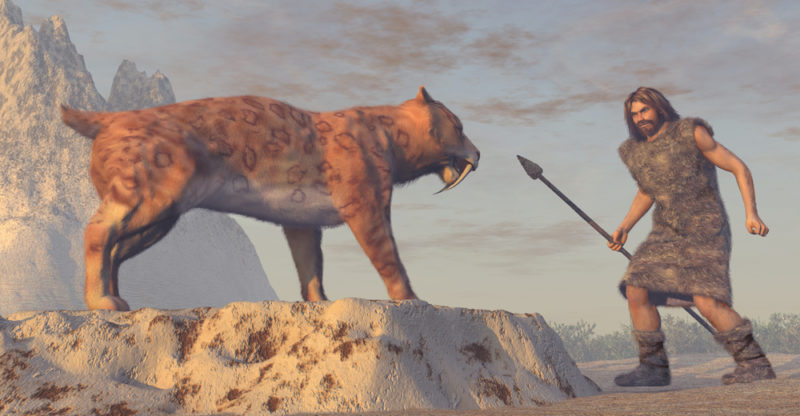We explain what prehistoric man is, his characteristics and evolution. In addition, we explore the first hominids, discoveries, and more.

What is prehistoric man?
The term "prehistoric man" refers to prehistoric human beings that existed during evolutionary stages prior to modern humans.
The expression “prehistoric man” or "primitive man" makes reference to human evolution during prehistory. This term traditionally encompassed all human groups that existed until the invention of writing, spanning millions of years, from the emergence of Homo habilis (2.5 million years ago) to the development of the first written records (3,300 BC).
Today the term is falling into disuse, being replaced by more specific concepts like "Paleolithic man" or "archaic man", and is no longer used in academic contexts to refer to men of the Neolithic period (circa 8,000-3,000 BC).
In its traditional conception, prehistoric man belongs to the biological family of hominids, which includes primates such as chimpanzees, gorillas, and humans. While primates can be identified as a common ancestor to all hominids, humans became a distinct species through the hominization process.
The genus Homo encompasses all species that were part of the human evolutionary process. Various types of hominids existed, coexisting and populating the world in different regions and time periods in history. Homo sapiens sapiens is the human species that adapted to environmental changes and survived the extinction of other species.
- See also: Human evolution
Early hominids
Archaeological evidence has made it possible to reconstruct prehistory. Among the first hominids are:
- Australopithecus. More similar to apes than to the Homo species. It evolved in East Africa around four million years ago and became extinct about two million years ago.
- Homo habilis. This species lived between 2.6 and 1.5 million years ago. It had common traits and coexisted with Australopithecus, though it exhibited a larger cranial capacity and more advanced hand dexterity.
- Homo erectus. This species succeeded Homo habilis, which dates back one and a half million years. It differed from previous hominids in its more slender body build, greater height, and increased cranial capacity.
- Homo sapiens. This species evolved from Homo erectus, its oldest remains in its archaic form dating from 500,000 years ago. They were characterized by a greater height, and increased cranial capacity. Homo sapiens crafted more elaborate tools, made more complex use of language, and buried their dead.
- Homo neanderthalensis. This species existed from 230,000 to 30,000 years ago. Today it is considered a subspecies of Homo sapiens, along with Homo sapiens sapiens, with which it coexisted for thousands of years. Neanderthals were hunters and lived in large groups.
- Homo sapiens sapiens. It is the species to which modern humans belong. The oldest archaeological remains date back 100,000 years. For the last 30,000 years it has been the only surviving species of the genus homo.
Evolution of early humans
Distinct biological traits that differentiated primitive man from the rest of the species include:
- Bipedalism, i.e. walking on two legs.
- Skeletal development, longer limbs and a shorter, sturdier pelvis.
- Upright posture, though initially with a slightly hunched back.
- Increased brain mass relative to body mass, an evolutionary process called "corticalization".
- Mental development, both conscious and unconscious, resulting from brain activity (an evolutionary process called cerebration).
- Hand development along with the brain's ability to control fine motor functions.
- Larger cranial cavity and smaller jaws.
Geographical distribution of prehistoric humans
Early human evolution involved slight variations in the genetic material, i.e. in the DNA (deoxyribonucleic acid), which contains the instructions for the development and functioning of organisms. Genetic information accumulated throughout different generations caused several evolutionary changes.
The most widely accepted theory holds that it is estimated that about 90,000 years ago Homo sapiens would have begun migrating from the African continent to various territories in Europe and Asia. Subsequently, around 60,000 years ago, they would have spread to Oceania.
Over 13,000 years ago, during the last glacial period of the Ice Age, a land bridge emerged, connecting Asia and North America. Primitive men would have migrated to the American continent via that pathway.
Different migrations were driven by factors which forced individuals to move to other regions in order to survive. These factors included food scarcity, the need for new resources, harsh climatic conditions, or natural disasters.
Early human discoveries

Early humans, i.e. ancestors of the genus Homo and their predecessors, made vital advances that changed the course of their descendants.
Prominent prehistoric discoveries include:
- Tool chiseling. Primitive men made small tools and utensils carved in bone and stone, used for tearing and cutting up animal meat, fruits and vegetables.
- Stone carving. Primitive men developed increasingly advanced and sophisticated techniques for carving stone, such as stone polishing, which allowed them to make stronger tools, even for working the land.
- Control of fire. It was one of the most significant discoveries in human history. Initially, it was used as a heat source in caves during freezing nights, for keeping away wild animals, providing light, and cooking.
Early human culture
The main cultural traits of primitive man were:
- Nomadism. Human groups did not live in a fixed place, but foraged for animals and followed seasonal cycles.
- Subsistence economy. Early humans fed on elements they found in nature, initially, fruits and vegetables they gathered, and carrion found dead or killed by other predators. Later, they became hunters of small, then larger animals using crafted tools and group hunting techniques.
- Bands. Nomadic lifestyle and subsistence economy favored the organization of humans into small groups or “bands”, consisting of 20 to 30 people. These groups were united by kinship ties and controlled the territories through which they foraged in search of resources.
- Egalitarian societies. Primitive men had no formal leaders or chiefs. An individual might stand out for his skills and was therefore held in high respect. Elders were looked up to for their experience and had greater authority in the resolution of conflicts. Nevertheless, they were egalitarian societies with no power hierarchies.
The end of primitive man
During the Neolithic period (8,000-3,000 BC), human groups developed knowledge and experience that profoundly changed human organization and gave rise to modern man:
- Animal husbandry. The observation of nature for long periods of time allowed primitive men to domesticate animals and plants. By selecting and breeding animals, men passed from controlled hunting (in which animals of reproductive age were preserved) to animal capture for breeding and control.
- Agriculture. Through the observation of plant growth and cycles, primitive men were able to select seeds and cultivate them. They developed irrigation and agricultural techniques to produce food.
- Settlements. The development of a production economy (animal husbandry and agriculture) gave rise to the first large settlements. Men built more complex constructions using more durable materials, and developed spaces not only for living, but also for storing resources and crafting tools and other material objects.
Explore next:
References
- López Serrano, A. (1996). Proceso de hominización y cultura material. La aportación de la antropología histórica.
- Harris, M. (1981). Introducción a la antropología general. Alianza.
- Leakey, R., & Lewin, R. (1994). Nuestros orígenes. RBA editores.
- “Homo sapiens and early human migration”. Khan Academy.
- “Human evolution”. Britannica.
- “Ancient humans: what we know and still don’t know”. New scientist.
- “Prehistoria en 6 minutos” (video). Academia play.
- “La historia de la evolución humana”. Nmas1.
- “Los conceptos básicos de la evolución humana”. National geographic.
- “Principales homínidos y su evolución: el origen del Homo sapiens”. Khan Academy.
Was this information useful to you?
Yes NoThank you for visiting us :)